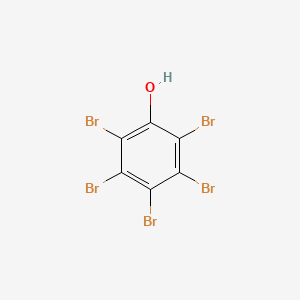D1042 | pentabromophenol
| Toxicity | Dose | Time | Species | Model | Method | Action | Positive criterion | Reference |
|---|---|---|---|---|---|---|---|---|
| MEMBRANE POTENTIAL | 3.46±0.99 | human | qHTS-HepG2 | MMP assay | decrease | IC50 | 163 | |
| MEMBRANE POTENTIAL | 7.94 | human | HepG2 | MMP assay | decrease | IC50 | 163 | |
| MEMBRANE POTENTIAL | 4.98±2.48 | rat | hepatocytes | MMP assay | decrease | IC50 | 163 | |
| Pictogram | Signal | Statements | Precautionary Statement Codes |
|---|---|---|---|
   |
Danger |
Aggregated GHS information provided by 42 companies from 2 notifications to the ECHA C&L Inventory. Each notification may be associated with multiple companies. H301 (100%): Toxic if swallowed [Danger Acute toxicity, oral] H311 (90.48%): Toxic in contact with skin [Danger Acute toxicity, dermal] H315 (100%): Causes skin irritation [Warning Skin corrosion/irritation] H319 (100%): Causes serious eye irritation [Warning Serious eye damage/eye irritation] H331 (90.48%): Toxic if inhaled [Danger Acute toxicity, inhalation] H335 (100%): May cause respiratory irritation [Warning Specific target organ toxicity, single exposure Respiratory tract irritation] H400 (90.48%): Very toxic to aquatic life [Warning Hazardous to the aquatic environment, acute hazard] Information may vary between notifications depending on impurities, additives, and other factors. The percentage value in parenthesis indicates the notified classification ratio from companies that provide hazard codes. Only hazard codes with percentage values above 10% are shown. |
P261, P264, P270, P271, P273, P280, P301+P310, P302+P352, P304+P340, P305+P351+P338, P311, P312, P321, P322, P330, P332+P313, P337+P313, P361, P362, P363, P391, P403+P233, P405, and P501; (The corresponding statement to each P-code can be found at the GHS Classification page.) |
   |
Danger |
H301: Toxic if swallowed [Danger Acute toxicity, oral] H335: May cause respiratory irritation [Warning Specific target organ toxicity, single exposure Respiratory tract irritation] H370: Causes damage to organs [Danger Specific target organ toxicity, single exposure] |
P260, P261, P264, P270, P271, P301+P310, P304+P340, P307+P311, P312, P321, P330, P403+P233, P405, and P501; (The corresponding statement to each P-code can be found at the GHS Classification page.) |
| Organism | Test type | Route | Dose (normalized dose) | Effect | Source |
|---|---|---|---|---|---|
| rat | LD50 | oral | 200mg/kg (200mg/kg) | "Prehled Prumyslove Toxikologie; Organicke Latky," Marhold, J., Prague, Czechoslovakia, Avicenum, 1986Vol. -, Pg. 527, 1986. | |
| mouse | LDLo | intraperitoneal | 250mg/kg (250mg/kg) | "Summary Tables of Biological Tests," National Research Council Chemical-Biological Coordination Center. Vol. 5, Pg. 288, 1953. | |
| 1e4h | 2,3,4,5,6-Pentabromophenol | 2,3,4,5,6-Pentabromophenol # |
| 2,3,4,5,6-pentakis(bromanyl)phenol | 3-06-00-00766 (Beilstein Handbook Reference) | 608-71-9 |
| A832934 | ACMC-1AWHG | AI3-01561 |
| AKOS003672224 | AS-13066 | AS04485 |
| BC003735 | BRN 1876757 | C-34165 |
| C6HBr5O | CAS-608-71-9 | CC-33524 |
| CCRIS 4853 | CHEMBL1235157 | CTK5B2381 |
| DB03167 | DSSTox_CID_2079 | DSSTox_GSID_22079 |
| DSSTox_RID_76480 | DTXSID9022079 | EINECS 210-167-3 |
| FCH1321427 | FT-0739390 | Flammex 5BP |
| HSDB 5500 | LS-1448 | MLS002152927 |
| NCGC00090884-01 | NCGC00090884-02 | NCGC00257893-01 |
| NSC 5717 | NSC-5717 | NSC5717 |
| PBR | PENTABROMOHYDROXYBENZENE | PENTABROMOPHENOL |
| Pentabromfenol | Pentabromfenol [Czech] | Pentabromophenol, 96% |
| Phenol, 2,3,4,5,6-pentabromo- | Phenol, pentabromo- | Phenol,2,3,4,5,6-pentabromo- |
| PubChem13350 | Q27094104; | SCHEMBL268325 |
| SMR001224527 | SVHOVVJFOWGYJO-UHFFFAOYSA-N | TC-165569 |
| Tox21_200339 | UNII-V89A88NMMX | V89A88NMMX |
| WLN: QR BE CE DE EE FE | ZINC1687157 | pentabromphenol |

